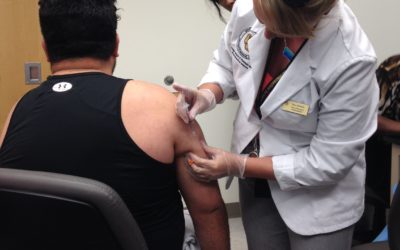There are two ways to battle the seasonal threat of the flu virus: prevention and treatment.
An Ounce of Prevention
The most effective way to protect yourself and your family this year is to get a flu shot. Unfortunately, it has been widely reported that this year’s flu vaccine has somewhat missed the mark on the most prevalent flu virus spreading across the country. Although the vaccine does not deliver a direct bull’s-eye, it will provide some protection against acquiring the flu and, if you do get it, the vaccine may very well lessen the duration and symptoms of the virus.
A Pound of Cure
Whether you received a flu shot this year or not, you may need to launch a counterattack if you do develop symptoms or have been exposed to someone who has the flu. If you’ve been exposed or suspect you’re infected, see your doctor at once!
There are several medications that can be effective at preventing or treating the flu, but they need to be taken within the first 48 hours of exposure (or developing symptoms), so act quickly! Tamiflu and Relenza have been approved to both prevent and treat the flu in the U.S. These two drugs also help lessen the total time you’re sick by one to two days, and they may make you less contagious to others.
Even if you are healthy now but at particular risk (elderly, asthmatic, etc.), speak to your doctor for a prescription (to use if you develop symptoms) to get ahead of the 48-hour treatment rule.
The Cost of Relief
Tamiflu and Relenza can be expensive treatment options, especially if you do not have insurance coverage. I’m sure you’ve seen the TV commercial with a giant guy in a tiny house taking his temperature and calling the doctor. That ad says the flu is a big deal, so don’t treat it like a little cold.
Like Tamiflu (oseltamivir phosphate), this commercial is effective AND expensive. Tamiflu costs around $160 for a 10-pill blister pack without insurance. Our prescription discount card allows users to get this treatment for 10-18% less depending on the pharmacy. Get our free discount drug card and use our online drug pricing tool to find the best price at a pharmacy near you.
If you have flu symptoms such as fever, chills, aches, malaise or even vomiting, doctors recommend rest. If you can, try to eat nourishing food and drink more fluids than you normally do. The effects of a fever can be dehydrating, so drinking more helps you replace what is lost. Water is always a good option, but soup can be a great alternative, especially if you don’t have much of an appetite.
Your body is under attack and needs to rest, so you should not exercise if you have chest congestion, a hacking cough, body aches or fever.
Over-the-Counter Medicine
Although over-the-counter fever reducers, antihistamines, decongestants and cough medicines may help you feel better; however, they will not help you recover any faster. Our free medication savings card offers discounts on several anti-viral medications, including Oseltamivir discounts and more.
Antihistamines can make you drowsy and are found in nighttime cold medicines. If you have heart disease or high blood pressure, speak to your doctor before taking decongestants since they can increase your blood pressure. Also, some decongestants can make some people feel jittery or nervous and may result in insomnia. Taking them with food may help.
As unpleasant as a fever may be, some doctors believe it helps deactivate the viruses that cause influenza. If you have a high fever or feel very uncomfortable, you may want to take fever reducers to help you rest. Fever stresses the heart and lungs; however, fever reducers may be appropriate for older people and those with heart or lung disease. If your fever continues to rise or doesn’t come down after two or three days, you should see your doctor.












